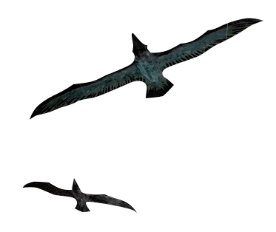Many of the works in the exhibition were made on the island of Bodö in the southern Finnish archipelago, where Katchadourian’s family have spent their summers ever since she was a child, as did the two previous generations of her maternal family.
The exhibition is installed throughout the National Nordic Museum. Two multimedia works are located within the Museum’s Barbro Osher Gallery. In the immersive installation To Feel Something That Was Not of Our World (2021), Katchadourian works with her intimate knowledge of the 1973 bestselling book, Survive the Savage Sea, which chronicles the true story of a family set adrift for 38 days in the Pacific Ocean after their sailboat was attacked by orca. Written by the father of the Robertson family, Survive the Savage Sea has preoccupied the artist since she first encountered it at age seven. In 2020, Katchadourian contacted the author’s eldest child, Douglas Robertson, and initiated a 38-day, daily conversation corresponding to the Robertsons’ time as castaways. Through audio excerpts, drawings, sculptures, and replicas of objects from the disaster, the gallery becomes a vessel for the story of the shipwreck and the intimate conversation between Robertson and Katchadourian. To Feel Something That Was Not of Our World is paired with The Recarcassing Ceremony (2016), a 24-minute film about an invented game the artist played with her brother Kai during their childhood summers in Finland, her mother’s country of birth. In this game, centered on two families of PLAYMOBIL figures, two key characters were lost at sea and Nina and her brother had to invent a ritual to bring them back to life. The Recarcassing Ceremony sheds light on how serious subjects are so often embedded in the seemingly lighthearted games of children.
Two works in Origin Stories focus on creative projects made by her Finlandswedish maternal grandparents during their summers in the Finnish archipelago. The photographic series The Nightgown Pictures (1997 – 2003) responds to her grandmother Nunni’s tradition of photographing Nina’s mother Stina on her birthday. Each year, Nunni took a picture of Stina in a small handmade nightgown, ending the year when she could no longer fit into it. Beginning in 1997, Nina and Stina revisited the locations depicted in the photographs and documented them again. The work becomes a catalyst for revisiting formative moments and locations in Stina’s childhood and sharing these encounters. Talla (2025), a bronze sculpture, will debut in the Museum’s East Garden. The sculpture is an exact scale replica of a cow constructed of found wooden sticks, made for Stina by her father Lale when she was about 12 years old. The original Talla, still existent but now very fragile, has been cared for by three generations of family and appears in many photo albums like a family pet. Casting Talla in bronze creates a lasting monument to Lale’s tender gift and to the importance of preserving artifacts such as these.
One of Katchadourian’s best-known works, Accent Elimination (2005), will be exhibited in the museum’s library, a space reserved for research on genealogy and cultural identity. Accent Elimination was displayed at the 2015 Venice Biennial as part of the Armenian Pavilion, which won the Golden Lion for Best National Participation. Via the subject of her parents’ complex accents—often the subject of curious questions from strangers—the six-channel video work speaks to the intricacies of assimilation, cultural identity, and diasporic heritage.
This exhibition is organized by the National Nordic Museum in collaboration with the artist.


